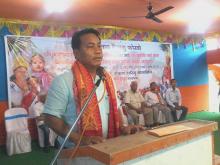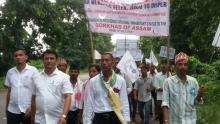Meghalaya went to polls on March 3 this year with a total of 331 candidates belonging to 13 political parties and 73 independent candidates in the fray for elections to the 60-member state assembly. In the run up to the polls, Congress President Sonia Gandhi and Prime Minister Manmohan Singh flew down to Meghalaya to campaign for the Congress while the BJP roped in Shatrughan Sinha. The Congress put up its candidates in all the 60 seats, while the UDP (United Democratic Party) contested 52 seats and the NCP (Nationalist Congress Party) contested 50 seats.
Following the declaration of the election results, the Congress emerged as the single largest party with 25 seats in the state assembly. To the amazement of many both within the state and outside, the Meghalaya governor S.S. Sidhu invited the Congress leader DD Lapang to form the next government and gave him ten days time to prove his majority on the floor of the House. On March 10, Lapang formed a new government. However, the rival Meghalaya Progressive Alliance (MPA) was not too pleased with the decision of the governor and went to the Supreme Court against the governor’s decision. However the apex court refused to interfere with the governor’s decision
As the days progressed, the claims of DD Lapang fell flat as he could not muster the requisite numbers to form the government. Many observers have alleged that DD Lapang tried to buy the support of the independent MLA’s by offering them ministerial berths, plunging Meghalaya politics into a new low. The Congress managed to rope in three Independent MLA’s forging an alliance named the Meghalaya United Alliance (MUA) but still fell short of three MLA’s to form a simple majority. Lapang was left with no alternative but to submit his resignation on March 19 ahead of the trust vote. The recent events has once again brought to the fore the fragile nature of governments in Meghalaya.
Following Lapang’s resignation, the Meghalaya Progressive Alliance(MPA)’s Donkupar Roy was sworn in as the Chief Minister. The Meghalaya Progressive Alliance(MPA), headed by the NCP leader P A Sangma comprises of 14 NCP MLAs, 11 UDP(United Democratic Party)MLA’s, two from the Hill State People's Democratic Party (HSPDP), one from the BJP and Khun Hynniewtrep National Awakening Movement (KHNAM) along with two Independents. For the Congress, this could not have come at a worse time, having already lost out in the elections in Tripura held on February 23 and Nagaland held on March 5 this year.
However there are doubts whether the new MPA government would be able to last its full five year term. Meghalaya has seen 20 governments since it was carved out of Assam and the MPA has just 31 MLA’s in the 60-member house. The NCP and the UDP have agreed to share the chief ministership and accordingly the NCP leader PA Sangma will take over as Chief Minister two and half years from now. A common minimum programme is being worked on. P.A. Sangma brings with him a rich experience in national level politics and is on friendly terms with most of the members of the Central government since he himself was a Union minister in the past and had also served as the Speaker of the Lok Sabha. It remains to be seen how much of his experience and “connections” he is able to use for the benefit of his home state.
There are many pressing problems in this “abode of clouds”(Meghalaya) and the government certainly has its hands full. The new government will have to spell out its stand on the controversial agreement between the previous government and some private companies to develop six power projects. Meghalaya has huge hydro-electricity potential like many other northeastern states. Uranium mining is another flash-point as it is fraught with disastrous consequences for the environment. The new government will have to grapple with the threat from various militant outfits operating within Meghalaya along with the problem of militant outfits like the ULFA setting up bases in Meghalaya. Meghalaya’s porous borders with Bangladesh are a cause for concern together with the rise of many Islamic fundamentalist groups in these border areas. The government will have to tackle the unemployment problem given the fact that many educated unemployed youths are turning to guns. Tourism can be a major revenue earner for this state which is blessed with spectacular natural beauty. Whether the new government is able to live up to the unenviable task at hand is a million dollar question.
-RUPAKJYOTI BORAH
PhD candidate, Jawaharlal Nehru University(JNU), New Delhi
Following the declaration of the election results, the Congress emerged as the single largest party with 25 seats in the state assembly. To the amazement of many both within the state and outside, the Meghalaya governor S.S. Sidhu invited the Congress leader DD Lapang to form the next government and gave him ten days time to prove his majority on the floor of the House. On March 10, Lapang formed a new government. However, the rival Meghalaya Progressive Alliance (MPA) was not too pleased with the decision of the governor and went to the Supreme Court against the governor’s decision. However the apex court refused to interfere with the governor’s decision
As the days progressed, the claims of DD Lapang fell flat as he could not muster the requisite numbers to form the government. Many observers have alleged that DD Lapang tried to buy the support of the independent MLA’s by offering them ministerial berths, plunging Meghalaya politics into a new low. The Congress managed to rope in three Independent MLA’s forging an alliance named the Meghalaya United Alliance (MUA) but still fell short of three MLA’s to form a simple majority. Lapang was left with no alternative but to submit his resignation on March 19 ahead of the trust vote. The recent events has once again brought to the fore the fragile nature of governments in Meghalaya.
Following Lapang’s resignation, the Meghalaya Progressive Alliance(MPA)’s Donkupar Roy was sworn in as the Chief Minister. The Meghalaya Progressive Alliance(MPA), headed by the NCP leader P A Sangma comprises of 14 NCP MLAs, 11 UDP(United Democratic Party)MLA’s, two from the Hill State People's Democratic Party (HSPDP), one from the BJP and Khun Hynniewtrep National Awakening Movement (KHNAM) along with two Independents. For the Congress, this could not have come at a worse time, having already lost out in the elections in Tripura held on February 23 and Nagaland held on March 5 this year.
However there are doubts whether the new MPA government would be able to last its full five year term. Meghalaya has seen 20 governments since it was carved out of Assam and the MPA has just 31 MLA’s in the 60-member house. The NCP and the UDP have agreed to share the chief ministership and accordingly the NCP leader PA Sangma will take over as Chief Minister two and half years from now. A common minimum programme is being worked on. P.A. Sangma brings with him a rich experience in national level politics and is on friendly terms with most of the members of the Central government since he himself was a Union minister in the past and had also served as the Speaker of the Lok Sabha. It remains to be seen how much of his experience and “connections” he is able to use for the benefit of his home state.
There are many pressing problems in this “abode of clouds”(Meghalaya) and the government certainly has its hands full. The new government will have to spell out its stand on the controversial agreement between the previous government and some private companies to develop six power projects. Meghalaya has huge hydro-electricity potential like many other northeastern states. Uranium mining is another flash-point as it is fraught with disastrous consequences for the environment. The new government will have to grapple with the threat from various militant outfits operating within Meghalaya along with the problem of militant outfits like the ULFA setting up bases in Meghalaya. Meghalaya’s porous borders with Bangladesh are a cause for concern together with the rise of many Islamic fundamentalist groups in these border areas. The government will have to tackle the unemployment problem given the fact that many educated unemployed youths are turning to guns. Tourism can be a major revenue earner for this state which is blessed with spectacular natural beauty. Whether the new government is able to live up to the unenviable task at hand is a million dollar question.
-RUPAKJYOTI BORAH
PhD candidate, Jawaharlal Nehru University(JNU), New Delhi







Comments
Add new comment